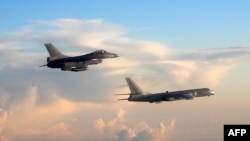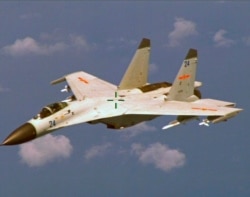The number of Chinese incursions into Taiwan’s airspace last year was the highest since 1996, which experts say is worsening the risk for conflict without drawing international headlines.
The Chinese People’s Liberation Army (PLA) flew about 380 sorties into Taiwan’s air defense identification zone (ADIZ) last year, a defense ministry statement said last week.
The PLA began dispatching warplanes toward the island after Taiwan's President Tsai Ing-wen was re-elected for a second term in January, but the activity dramatically increased in the second half of the year in 2020 and is now almost a daily occurrence.
According to a VOA compilation of flight data drawn from official statements by Taiwan’s Ministry of National Defense, Chinese warplanes have flown 138 of these missions since mid-September. Only four days into 2021, six Chinese warplanes had flown into the island's ADIZ.
Far fewer flights
By contrast, a Taiwan national defense report for the year 2017 said that during Tsai's first term, in the nearly 1½ years from August 2016 to December 2017, China sent only 26 sorties into Taiwan's airspace.
Experts said the increased operations were aimed at normalizing the incursions.
"The main message that the Chinese attached to these movements are they are routine Chinese operations," said Dr. Oriana Mastro, a Chinese military expert and resident scholar at the American Enterprise Institute, told VOA.
"This is very problematic. It doesn't make the news because this is happening every single day. It is problematic because, one, China is getting a lot of practice that really helps their military improve, but also they're trying to make their aggression and militarization the norm, routine, something that is not worthy of any sort of response from other nations."
A research report published on the website of Taiwan’s Ministry of National Defense stated earlier this month that on March 31, 2019, Chinese fighter planes deliberately flew across the strait center line for the first time since 1999. At that time, the incident was reported as the most serious provocation between Taiwan and China this century.
Last year, during the visit of U.S. Undersecretary of State Keith Krach to Taiwan in September, Chinese warplanes crossed the sensitive median line that separates the mainland and the self-governing island almost 40 times.
Beijing's art of fighting
Since late 1990s, Beijing had hoped for a peaceful reunification. It had introduced numerous preferential economic policies for Taiwan. However, there have been signs in recent years that Beijing has decided there is little chance for a peaceful reunification with Taiwan given the political reality in the island.
Wang Zaixi, former deputy director of the Taiwan Affairs Office of the State Council, recently said in an interview with Chinese media that there was a third way to choose between peaceful reunification and military invasion, which was to "promote reunification with force." Wang quoted from Sun Tzu's Art of War that China can “subdue the enemy without fighting.”
As China's military power tilts the military balance in the Taiwan Strait toward Beijing, analysts say the near-normalization of the Chinese military’s constant threats are aimed at subduing Taipei through exhaustion.
According to the latest data from the U.S. Defense Department, China has the largest air force in Asia and ranks third in the world. In its annual report on China's military and security developments to Congress, the Pentagon said the Chinese Air Force has more than 2,500 aircraft, including about 2,000 fighter jets.
By contrast, according to research by the Federation of American Scientists, Taiwan has far fewer fighter jets. "Taiwan, which has 289 combat aircraft, will likely be unable to match China’s current operational tempo if the escalated intrusion rate continues into the mid- to long term," the report said.
Taiwan’s National Defense Ministry said last week that Taiwan’s military was now "day and night, regardless of holiday," holding fast to its posts, monitoring the situation and adapting properly.
Taiwan understands
On the other hand, analysts also point out that Taiwan is fully aware of China’s approach, and there is little chance Beijing will succeed in subduing Taiwan.
Yisuo Tzeng, director at the Institute for National Defense and Security Research, told VOA that Taiwanese people understand that "Beijing is using superior resources to conduct asymmetric warfare against Taiwan. Taiwan will use smart and cautious methods and use open and transparent methods to allow the entire society to have a full understanding."
Craig Singleton, a researcher at the Foundation for Defense of Democracies, a nonpartisan think tank in Washington, said that China portrays these military incursions as normal and routine training in an effort to hide from strong international reactions, but they may end up undermining China in the long term.
"All of China's flyovers and buildup have done nothing to deter increased U.S. collaboration with Taiwan." Singleton told VOA. He said in some respects, these kinds of aggressive moves have been unsuccessful in deterring the U.S. or really even strengthening China's hands, "because those aggressive moves have really been quite scary to all of China's regional neighbors, who are sitting there and saying, ‘Maybe I need to get a little closer to the United States.’ "










